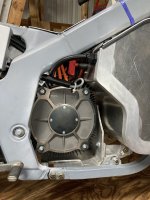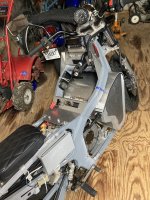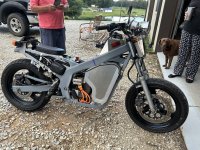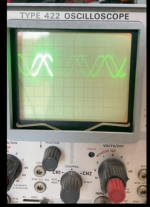MrCherbike
100 µW
We have built an electric Suzuki GS 550. Motor is Motenergy ME1905 with Sin/Cos analog encoder and Kelly 8080IPS controller. Batteries are 2P/30S Headway 40152S for 30Ah and 96V. It has a Domino potentiometer throttle. Has been operating about one year now. Generally works very well, but of course a problem has been there since the start that has me baffled here which I am getting tired of chasing and now am asking for ideas.
Roughly about one in thirty starts from a dead stop get a shutdown "Hall Error". I had to push it home without shutting it off to get that reading since this Kelly drive has no easy form of telemetry and I connect it to a PC. If you shut off the isolated 12V to the controller it resets and you are on your way and it may never happen again on that drive. Only in the first ten to twenty feet, never at speed or accelerating while cruising. I am aware that locked rotor(like from a dead stop) is the most difficult for the drive to perform. The actual voltages of the Sin/Cos were measured from a breakout box I installed for that purpose, and they are dead-on and the thing performs the Identification Angle with no problem. I am discounting loose crimps and such things because it only happens during initial acceleration and also the machine gets a lot more jolts and jarring form road bumps. Contact with Kelly has not been forthcoming with ideas. All the parts are new(withing one year). I have been wondering if there is any other type of input to that "Hall Error" besides something to do with the Sin/Cos system. It also might trip as soon as you take it out of the shed or if it is warm. I have physically moved the high current wires to be as far apart as possible, and rotated motor 180 degrees in it's mount to achieve that. Also am using all the shielding connections provided and installed steel enclosures for the control plugs and cabling. The 12V supply is of the isolated switching type and never drops out(the main contactor stays energized).
Lastly I wish Kelly would provide more detailed information in their manual like other manufacturers of VFD devices do and more properly translated it would give more confidence to us! Attaching a few pics have many more including full schematics. The motor has been rotated 180 degrees in it's mount since that last pic.
Thanks in advance!
Roughly about one in thirty starts from a dead stop get a shutdown "Hall Error". I had to push it home without shutting it off to get that reading since this Kelly drive has no easy form of telemetry and I connect it to a PC. If you shut off the isolated 12V to the controller it resets and you are on your way and it may never happen again on that drive. Only in the first ten to twenty feet, never at speed or accelerating while cruising. I am aware that locked rotor(like from a dead stop) is the most difficult for the drive to perform. The actual voltages of the Sin/Cos were measured from a breakout box I installed for that purpose, and they are dead-on and the thing performs the Identification Angle with no problem. I am discounting loose crimps and such things because it only happens during initial acceleration and also the machine gets a lot more jolts and jarring form road bumps. Contact with Kelly has not been forthcoming with ideas. All the parts are new(withing one year). I have been wondering if there is any other type of input to that "Hall Error" besides something to do with the Sin/Cos system. It also might trip as soon as you take it out of the shed or if it is warm. I have physically moved the high current wires to be as far apart as possible, and rotated motor 180 degrees in it's mount to achieve that. Also am using all the shielding connections provided and installed steel enclosures for the control plugs and cabling. The 12V supply is of the isolated switching type and never drops out(the main contactor stays energized).
Lastly I wish Kelly would provide more detailed information in their manual like other manufacturers of VFD devices do and more properly translated it would give more confidence to us! Attaching a few pics have many more including full schematics. The motor has been rotated 180 degrees in it's mount since that last pic.
Thanks in advance!





